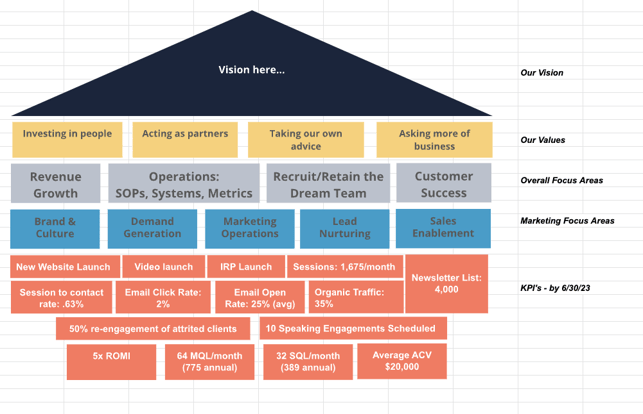Let’s face it. Marketing plans can be tedious to create. They can be overly detailed, long-winded, and might even struggle to show how they tie back to the business growth as a whole. After all, how many marketing teams actually hold themselves accountable to generating a percentage of revenue or hitting their KPIs?
At 1 Bold Step, we’ve developed our Strategic Marketing Plan (also known as the “marketing house”) to solve this problem.
We create a marketing house on an annual basis to help teams visualize and simplify how marketing will support the growth of the business in the coming year. And even call out the KPI’s that should be tracked to prove success.
The Anatomy of the Marketing House:
- Your overall business vision or north star
- Your organization's values
- The business focus areas or areas that need to grow to reach your defined vision. (Many times this comes from leadership and a strategic plan)
- The marketing focus areas that will support and drive your overall business focus areas
- And your KPIs (key performance indicators) that you will use to measure the success of your marketing.
Without this… marketing teams often act without a clear target, instead of as a natural extension of your organization. If you don't know where your target is, you'll be lucky to land any arrows. This is the same with your marketing goals.
By completing a Strategic Marketing Plan, “building a house”, and setting tangible KPIs, we can accurately assess the benefits of marketing in any organization.
So let’s break it down.
Step 1: Define Your Business’ Vision or “North Star”
When we don’t know where we are headed as a team, it’s easy to be distracted and spend our time, energy, and money on things that don’t actually support business growth.
We define the north star (or your business vision) with your team by looking into pieces of our business that are true to the business and yet different from others. Creating a desired image of your business that you would hope to be in the coming 1-3 years that we can strive to create. This image should have qualitative and quantitative features, and be realistically achievable.
Overall, know why you’re making an effort and where you plan to end up with your organization after you do. Answer the question… “Where are we going as an organization?”
Step 2: Defining Your Company Focus Areas
Defining business focus areas is the process of clarifying what parts of the business need to grow in order to reach our north star. Because we are looking at the business as a whole, we’re not thinking of what needs to be done in a single vertical but from every aspect of the business — from culture building, to the hard financials, and everything in between.
For example, your focus areas could be things like:
- Talent development through recruiting and retaining employees
- Increasing revenue by launching a new product or service
- Completing a merger/acquisition of another company in the coming year
The overall business focus areas likely won’t feel like they fall on the shoulders of the marketing team, but without having a clear understanding of what these business focuses are, we cannot define proper marketing focus areas or tactics that support them. And at the end of the day, that’s always the goal — for marketing to grow the business.
Step 3: Defining Your Marketing Focus Areas
Now it’s time to define what the marketing team is going to focus on for the year. At this point, we’re not worried about tactics or tangible efforts that will be carried out through the year. Overall, we’re defining larger marketing buckets that could directly impact the business’ focus areas that were defined in step 2.
These focus areas might look like:
- Demand generation/capture
- Higher recurring revenue and talking to customers
- Improving brand awareness or loyalty within your target audience
- Systems and operational help on the backend to collect and measure data for the organization
Focus areas like these allow the marketing department to have a seat at the table in supporting business growth. At the end of the day, we always want to be able to attribute our effort to a result.
Step 4: Defining Your Marketing Tactics
Now that our marketing focus areas are defined, it’s time to create tangible, actionable next steps to reach those goals and measure the success of our efforts.
What is the marketing team going to do to make sure that we are increasing the demand for the services provided, or the number of leads that come through the door? How many leads do we need to create to consider our efforts in this space a success? 
These tactics are going to be things like:
- Creating 4 outbound email campaigns centered around A industry or B service offerings
- Hosting events that showcase your products and services and strengthen the relationships in your community
- Starting a podcast, recording 50 episodes in the year, and bringing on 12 guests that will help us tap into new audiences.
- SEO work. Writing 24 blogs, optimizing web content, and building conversion funnels.
- Website updates that will make it easier for your customers to buy, and work as a sales tool for your team.
- Paid media efforts that expand the reach of your messaging.
The list of tactics can be extensive. What’s important is that we choose tactics that not only directly support marketing focus areas, but our business focuses as well. These tactics should be measured in a way that will show us the overall success of our actions.
Step 5: Define Your KPIs
The KPIs you choose to define will change depending on the focus areas chosen, and what your team considers a success.
Marketing KPIs will be things like:
- How many new products are sold to existing customers
- Podcast downloads
- Email open and clickthrough rates
- Marketing Qualified Leads or Sales Qualified Leads
These KPIs give you a good idea of what your audience is interested in.
Business KPIs that will prove your ROMI (return on marketing investment) will be things like:
- Closed-won deals from certain lead sources
- Influenced revenue
- A percentage of new revenue generated specifically from marketing activity
This proves whether your marketing is truly working or not.
Step 6: Prioritize Your Marketing Tactics
By the time goals, potential tactics, and key performance indicators are defined, one thing is necessary to understand — we likely won’t be able to do all of the things that we’ve set out to accomplish.
It’s also imperative to understand that some tactics will be much more impactful — and therefore are more important than others. This means we need to prioritize where our time and budget is allocated to.
At 1 Bold Step, we use a rating system of 1-3. If a tactic is voted a 1, that means it is a MUST DO in the next calendar year. Regardless of effort or budget, it is essential that this happens for business growth.
Rating something a 2 would mean that it is important. But if it is delayed behind a few other tactics, or pushed down the road, we would survive.
Anything ranked a 3 would mean, “Yes, this was a nice idea, but we could probably do without it.”
From there, we build a list of tactics to complete in order of priority to get approved — along with a budget for those tactics, and an estimated ROI.
We put all this together to create your Strategic Marketing Plan “House” that looks something like this.

Let's Get Started
If you or your organization could benefit from defining clear and trackable marketing goals, creating your strategic marketing house would be a great next step. You have all of the tools you need to start yourself, but if you would like the help of our team to get you started on the right foot, you can reach out to us through our website or book a call with us here.



.png?width=700&name=content-3679757_640%20(1).png)

